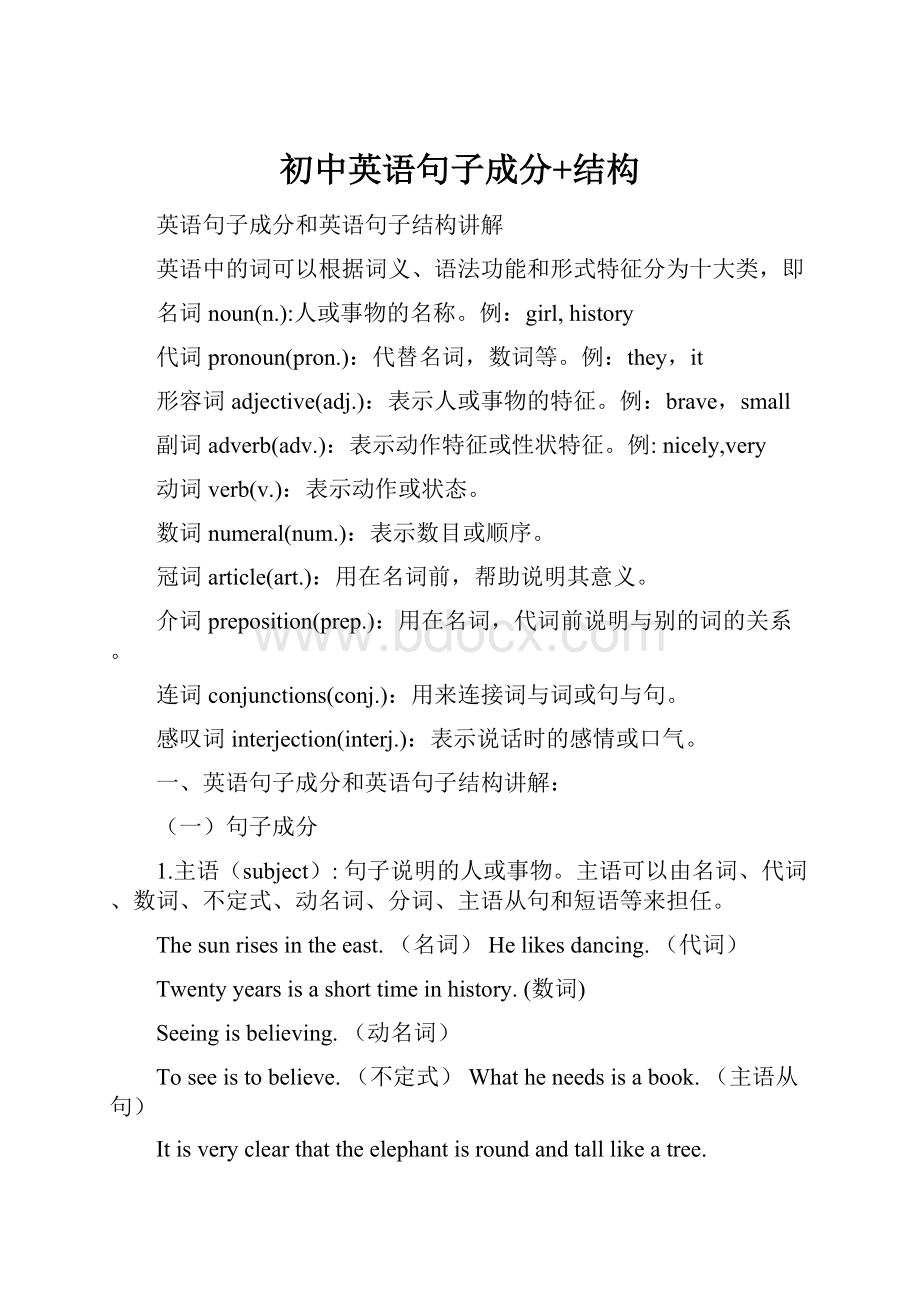初中英语句子成分+结构.docx
《初中英语句子成分+结构.docx》由会员分享,可在线阅读,更多相关《初中英语句子成分+结构.docx(20页珍藏版)》请在冰豆网上搜索。

初中英语句子成分+结构
英语句子成分和英语句子结构讲解
英语中的词可以根据词义、语法功能和形式特征分为十大类,即
名词noun(n.):
人或事物的名称。
例:
girl,history
代词pronoun(pron.):
代替名词,数词等。
例:
they,it
形容词adjective(adj.):
表示人或事物的特征。
例:
brave,small
副词adverb(adv.):
表示动作特征或性状特征。
例:
nicely,very
动词verb(v.):
表示动作或状态。
数词numeral(num.):
表示数目或顺序。
冠词article(art.):
用在名词前,帮助说明其意义。
介词preposition(prep.):
用在名词,代词前说明与别的词的关系。
连词conjunctions(conj.):
用来连接词与词或句与句。
感叹词interjection(interj.):
表示说话时的感情或口气。
一、英语句子成分和英语句子结构讲解:
(一)句子成分
1.主语(subject):
句子说明的人或事物。
主语可以由名词、代词、数词、不定式、动名词、分词、主语从句和短语等来担任。
Thesunrisesintheeast.(名词)Helikesdancing.(代词)
Twentyyearsisashorttimeinhistory.(数词)
Seeingisbelieving.(动名词)
Toseeistobelieve.(不定式)Whatheneedsisabook.(主语从句)
Itisveryclearthattheelephantisroundandtalllikeatree.
(It形式主语,主语从句是真正主语)
2.谓语(predicate):
说明主语的动作、状态和特征。
WestudyEnglish.Heisasleep.
3.表语(predicative):
系动词之后的成分,表示主语的性质、状态和特征。
Heisateacher.(名词)Seventy-four!
Youdon’tlookit.(代词)
Fiveandfiveisten.(数词)Heisasleep.(形容词)
Hisfatherisin.(副词)Thepictureisonthewall.(介词短语)
Mywatchisgone/missing/lost.(形容词化的分词)
Towearafloweristosay“I’mpoor,Ican’tbuyaring.(不定式)
Thequestioniswhethertheywillcome.(表语从句)
★(常见的系动词有:
be,sound(听起来),look(看起来),feel(摸起来,smell(闻起来),
taste(尝、吃起来),remain(保持,仍是),feel(感觉)...
Itsoundsagoodidea.Thesoundsoundsstrange.
Hervoicesoundssweet.Tomlooksthin.
Thefoodsmellsdelicious.Thefoodtastesgood.
Thedoorremainsopen.NowIfeeltired.
4.宾语:
1)动作的承受者-----动宾
IlikeChina.(名词)Hehatesyou.(代词)
Howmanydoyouneed?
Weneedtwo.(数词)
Weshouldhelptheoldandthepoor.Ienjoyworkingwithyou.(动名词)
Ihopetoseeyouagain.(不定式)Didyouwritedownwhathesaid?
(宾语从句)
2)介词后的名词、代词和动名词-----介宾
Areyouafraidofthesnake?
Underthesnow,therearemanyrocks.
3)双宾语-----间宾(指人)和直宾(指物)
Hegavemeabookyesterday.Givethepoormansomemoney.
5.宾补:
对宾语的补充,全称为宾语补足语。
Weelectedhimmonitor.(名词)Weallthinkitapitythatshedidn’t
comehere.(名)
Wewillmakethemhappy.(形容词)Wefoundnobodyin.(副词)
Pleasemakeyourselfathome.介词短语)Don’tlethimdothat.(省to不定式)
Hisfatheradvisedhimtoteachthelazyboyalesson.(带to不定式)
Don’tkeepthelightsburning.(现在分词)I’llhavemybikerepaired.(过去分词)
6.主补:
对主语的补充,全称为主语补足语。
Hewaselectedmonitor.Shewasfoundsinginginthenextroom.
Hewasadvisedtoteachthelazyboyalesson.
7.定语:
修饰或限制名词或代词的词、词组或句子。
AiYanlingisachemistryteacher.(名词)Heisourfriend.(代词)
Webelongtothethirdworld.(数词)
Hewasadvisedtoteachthelazyboyalesson.(形容词)
Themanoverthereismyoldfriend.(副词)
Thewomanwithababyinherarmsismysister.(介词)
TheboysplayingfootballareinClass2.(现在分词)
Thetreesplantedlastyeararegrowingwellnow.(过去分词)
Ihaveanideatodoitwell.(不定式)
YoushoulddoeverythingthatIdo.(定语从句)
8.状语:
用来修饰v.,adj.,adv.,或句子。
表示时间、地点、原因、结果、程度、条件、方式和让步。
(以下例句按上述顺序排列)
Iwillgotheretomorrow.
Themeetingwillbeheldinthemeeting-room.
Themeatwentbadbecauseofthehotweather.
HestudieshardtolearnEnglishwell.
Hedidn’tstudyhardsothathefailedintheexam.Ilikesomeofyouverymuch.
Ifyoustudyhard,youwillpasstheexam.Hegoestoschoolbybike.
Thoughheisyoung,hecandoitwell.
(二)句子结构
简单句的五个基本句型
1.主语+不及物动词Shecame./Myheadaches.
2.主语+及物动词+宾语ShelikesEnglish.
3.主语+系动词+表语Sheishappy.
4.主语+双宾动词+间接宾语+直接宾语ShegaveJohnabook.
5.主语+宾补动词+宾语+宾语补语Shemakeshermotherangry.
Theteacheraskedmetoreadthepassage.
★There+be句型
Therearesomebooksonthedesk.
Thereliesabookonthedesk.
Exercises:
分析下列句子成分
1.Ourschoolisnotfarfrommyhome.2.Itisagreatpleasuretotalkwithyou
3.Allofusconsideredhimhonest.4.Mygrandfatherboughtmeapairofsportsshoes.
5.Hebrokeapieceofglass.6.Hemadeitclearthathewouldleavethecity.
翻译练习:
主谓结构(主语+不及物动词)
1、Youshouldstudyhard.
2、Shewenthomeverylateyesterdayevening.
练习:
1、Thisboxweighsfivekilos.这个盒子重五公斤。
2、IlivedinBeijingfiveyearsago.五年前我住在北京。
主谓宾结构(主语+及物动词+宾语)
1、Iwrotealetterlastnight.
2、Iwanttotalkwithyouthisafternoon.
练习:
1、AllofusbelievethatJackisanhonestboy.我们大家都相信Jack是一个诚实男孩。
2、Hedidnotknowwhattosay.他不知道说什麽好。
主系表结构(主语+系动词+表语)
1.Mybrothersareallcollegestudents.2Inwinter,thedaysareshortandthenightsarelong.
2.MrsBrownlooksveryhealthy.4Attheageoffifteenhebecameafamouspianist.
练习:
1、树叶已经变黄了。
Theleaveshaveturnedyellow.
2、这个报告听起来很有意思。
Thereportsoundsinteresting.
双宾语结构(主语+双宾动词+间接宾语+直接宾语)
1.MrJohnsontaughtusGermanlastyear.
2.Grandmatoldmeaninterestingstorylastnight.
练习:
1、请你给我弄一本新的,好吗?
Willyoupleasegetmeanewcopy?
2、我替你叫辆出租汽车好吗?
ShallIcallyouataxi?
复合宾语结构(主语+动词+宾语+宾语补足语)
1.WecallherAlice.
2.HisparentsnamedhimJohn.
练习:
1、学校定了一条规则,开始上课时学生要起立。
Theschoolmadeitarulethatthestudentsshouldstandupwhenclassbegins.
2、我认为与那个人谈话是无益的。
Ithoughtitnousetalkingwiththatman
Therebe句型
1.Thereisn’tgoingtobeameetingtonight.
2.Therewasonlyawellinthevillage.
练习:
1、铃响了。
2、一周有七天。
二、英语句子种类讲解:
按照句子的用途,英语句子可分为陈述句、疑问句、祈使句和感叹句。
按照句子的结构,英语句子可分为简单句、并列句和复合句。
中考对句子的考查主要集中在以下几个方面:
1.陈述句的构成形式及基本用法;
2.祈使句的构成形式及基本用法;
3.一般疑问句、特殊疑问句、选择疑问句、反意疑问句的构成形式及基本用法;
4.由what,how引导的感叹句的构成形式、用法及区别
对于各种从句的用法我们在后面分别论述。
(一.)陈述句的构成形式及基本用法
1.陈述句:
陈述句是用来陈述一个事实或表达说话人看法(包括肯定和否定)的句子。
通常用降调,句末用句号“.”。
Tomhasanewcar.
Theflowerisn’tbeautiful.
2.陈述句否定式的构成
(1)如果肯定陈述句的谓语部分含有助动词、情态动词或连系动词be,则只需在这些动词后加not即可构成否定式。
Heisplayingtheguitar.(肯定)
Heisnotplayingtheguitar.(否定)
Wecangettherebeforedark.(肯定)
Wecan’tgettheebeforedark.(否定)
(2)如果陈述句的谓语动词是实义动词,而其中又没有情态动词或助动词时,则需根据人称和时态在该实义动词前加don’t,doesn’t或didn’t。
同时把该实义动词变为原形。
Heplaystheviolinwell.(肯定)
Hedoesn’tplaytheviolinwell.(否定)
Shewonthegame.(肯定)
Shedidn’twinthegame.(否定)
(3)如果句子是therebe结构或谓语动词是have(有),除了be和have之后加not之外,句中如果有some要变为any。
例如:
Thereissomewaterinthecup.→Thereisnotanywaterinthecup.
Hehassomebooks.→Hehasnotanybooks.
(4)除not以外,否定词no,never,nothing,nobody,few等也可构成否定句。
例如:
Thereissomethingwrongwithhisbike.→Thereisnothingwrongwithhisbike.
Ihaveseenthefilm.→Ihaveneverseenthefilm.
(二.)祈使句的构成形式及基本用法
祈使句是用来表示命令、请求、建议、号召等的句子,谓语动词用原形,句末用感叹号“!
”或句号“.”。
朗读时一般用降调。
1.肯定的祈使句:
(1)祈使句主语是you时,you常省略,但如果要特别强调对方或表达某种强烈的情绪时可以有主语或称呼语。
Bequiet.
Youbequiet!
(2)“Do+祈使句”表示一种强烈的感情或请求,do起强调作用。
Docomebackatonce!
Dobecareful.
(3)please用在祈使句中可以表示一种客气的语气,但please用在句末时,必须用逗号与其余部分分开。
Openthewindow,please.
(4)Let引导祈使句时,后面需跟上人称代词或称呼语,人称代词一般只用第一、第三人称。
LetJackwaitaminute.
Let’sgotoschool.
(5)在祈使句中,Let’s和Letus是有区别的。
Let’s包括说话者,而Letus不包括听话者在内。
这点从反意疑问句时可明显看出。
Let’sgoskating,shallwe?
(表示内部的建议)
Letustryagain,willyou?
(表示向别人发出请求)
2.否定祈使句通常以Don’t或Never开头。
其结构通常是:
“Don’t(Never)+动词原形+其他成分”例如:
Don’tdothatagain!
Neverleavetoday’sworkfortomorrow!
Don’tbelatenexttime!
(三.)一般疑问句、特殊疑问句、选择疑问句、反意疑问句的构成形式及基本用法
1.一般疑问句:
(1)一般疑问句的肯定形式
一般疑问句一般是指以助动词、情态动词、be动词或have(有)开始,通常要求以yes,或no来回答的疑问句,一般疑问句读时通常用升调。
DoyouknowMr.Smith?
Canyouswim?
(2)一般疑问句的否定结构
①在一般疑问句的否定结构中,把副词not放在一般疑问句的主语之后。
但如果用not的简略形式-n’t,则须将-n’t与一般疑问句句首的be,have,助动词或情态动词写在一起。
在实际运用中,一般都采用简略式。
Areyounotafootballfan?
Aren’tyouafootballfan?
Willshenotlikeit?
Won’tshelikeit?
②与汉语不同的是,英语一般疑问句否定结构的答语是否定还是肯定,全由答语的否定或肯定来决定。
若答语是肯定的,则用yes加肯定结构;若答语是否定的,则用no加否定结构。
Aren’tyouafootballfan?
你不是足球迷吗?
Yes,Iam.\No,Iamnot.
Won’tshelikeit?
Yes,shewill.\No,shewon’t.
2.特殊疑问句
特殊疑问句由“疑问代词或疑问副词+一般疑问句”构成,句子一般用倒装语序,但如果主语是疑问代词或由疑问代词修饰时,用陈述句的语序。
特殊疑问句不能用yes或no回答,读时用降调。
例如:
Whoisondutytoday?
HowlonghaveyoubeeninBeijing?
Whattimedoyougetupeverymorning?
WhatmustIdonow?
常用的特殊疑问句
询问内容
疑问词或句型
例句
回答
职业,身份
what
Whatisyourfather?
Heisadoctor.
姓名或关系
who
Whoisthatboy?
HeisJack.
Heismybrother
相貌特征
what…like?
Whatisshelike?
Whatdoesshelooklike?
Sheisbeautiful.
目的
what…for?
Whatdidtheycomeherefor?
Toattendameeting.
原因
why
Whydidtheycomehere?
Becausetheyhaveameetingtoattend.
天气
how
what…like?
Howistheweathertoday?
Whatistheweatherliketoday?
It’sfine.
颜色
whatcolor…?
Whatdolorisherskirt?
It’sred.
服装尺寸
whatsize
Whatsizedoeshewear?
Hewars40.
几点钟
whattime
Whattimeisit?
It’s7:
30.
星期几
whatday
Whatdayistoday?
It’sTuesday.
几号,日期
whatisthedate…?
Whatisthedatetoday?
It’sMay2.
年龄(多大)
howold
Howoldishe?
Heis38.
持续多长时间(多久)
howlong
Howlonghaveyoubeenhere?
Forfivemonths.
长度(多长)
howlong
Howlongisthebridge?
It’s500metres.
距离(多远)
howfar
Howfarisitfromheretothezoo?
It’s6kilometres.
频度
(多经常)
howoften
Howoftendoyoucomeback?
Onceaweek.
时间经过
(多快)
howsoon
Howsoonwillshearrive?
Inanweek.
数量
(多少)
howmany(可数名词)
howmuch(不可数名词)
Howmanyjacketsdoyouhave?
Howmuchcoffeedoyouwant?
Three.
Twocups.
价格
howmuch
Howmuchisit?
Howmuchdoesitcost?
Fivedollars.
高度
(多高)
howtall(人,树)
howhigh(山,建筑物)
Howtallisshe?
Howhighisthetower?
She’s1.73metres.
It’s450metres.
3.选择疑问句:
选择疑问句是说话者提出两种或两种以上的不同情况,让对方选择回答的疑问句。
其结构是“疑问句+选择部分”。
选择部分由or连接,or前面的部分读升调,or后面的部分读降调。
选择疑问句不能用yes或no回答,而必须具体的选择答复。
Isyourbagyelloworblack?
It’sblack.。
Wouldyoulikesometeaorcoffee?
Eitherwilldo.。
Whichdoyoulikebetter,singingordancing?
Ilikedancingbetter.
4.反意疑问句:
反意疑问句(tagquestion)又叫附加疑问句,是在陈述句后,对陈述句所叙述的事提出的疑问。
其基本结构有两种:
一“肯定陈述句+简略否定问句”;
二“否定陈述句+简略肯定问句”。
反意疑问句的前后两部分在时态,人称和数上都要保持一致。
Itlookslikerain,doesn’tit?
Hedoesn’tneedtoworksolate,doeshe?
(1)肯定的陈述句后跟否定的附加问句,否定的陈述句后跟肯定的附加问句。
Iamyourteacher,aren’tI?
H